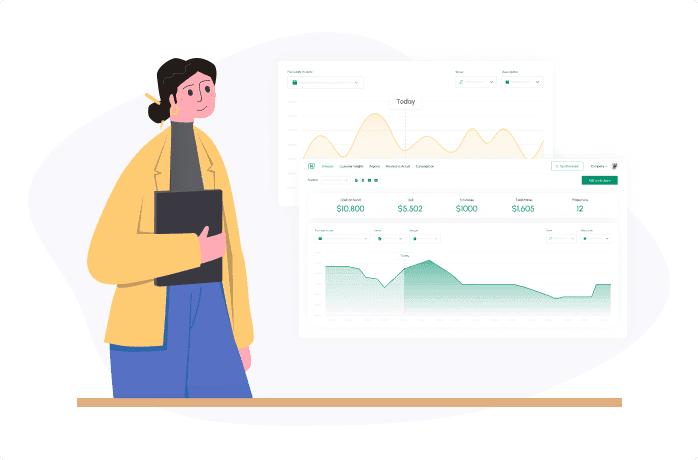Daily Cash Flow Forecast

Daily cash flow for business is crucial because it shows you how much money comes in and goes out of a business daily. If average daily cash flow falls below profitable levels, it will require you to make important changes to either:
- Boost incoming cash
- Lower expenditures
Small business daily cash flow is essential. Let's see why.
Why daily cash flow forecasting?
Most companies want balanced daily cash flow, but a 30-day or 60-day forecast often doesn't show you the refined data you need to make smart business decisions. Daily forecasts allow you to understand your short-term cash flow obligations.
A few businesses benefit from these forecasts the most:
- Small businesses operating on very thin margins
- Companies working on capital cycles
Shareholders and investors appreciate this data, too. If you're trying to raise capital, create daily cash flow reports. These reports show how a business grows day by day. They provide insight into slow days and days you may not want to remain in operation each week.
Daily cash flow management
Management of daily cash flow is important because it allows you to stay out of debt, pay bills on time and make smarter business decisions. If you want to improve and boost your daily cash flow, you can do so by managing:
- Expenditures until you have adequate capital and cash flow
- Receivables, so that you collect payments daily
- Cash flow resources
Projections allow you to manage your cash flow more effectively so that you have the short-term cash to make smart business decisions. Without adequate cash flow, your business may have to take on debts or raise more capital to stay in operation.
If you're operating a small business that is just trying to capture market share, daily cash flow management is one of the most important steps you can take to maintain a positive cash reserve and grow your business.

Why do companies set up a daily cash flow forecast?
Internal and external factors can lead to your business opting to generate a daily cash flow report. A few of the reasons to switch to receiving daily cash flow figures are:
- Credit agreements demand that you have net cash positives each day.
- Administration requires daily forecasts to have refined management measures in place.
- A revolving line of credits exists, and forecasting is required to keep the line open.
- Owners or managers need detailed cash flow information for business planning.
Having this information available allows you to perform a daily cash flow analysis and make smarter business decisions. The data can also reveal key issues, such as a lack of cash flow due to slow payments from customers.
Often, money is tied up in accounts receivable, leading you to believe that a business has the cash flow to make certain decisions when it does not.
Businesses need this information when they want to know their daily cash flow because cash reserves are often low. When cash reserves are low, it’s difficult to keep operations going for long without a loan or additional credit.

Main uses of a daily cash flow forecast
Why would you ever need to run a daily cash flow forecast? There are a few reasons, such as learning what your short-term liquidity is at any given time. For example, what level of liquidity will you have next week?
If you don't know, a forecast can tell you.
It's really that simple. Daily forecasts help you understand your liquidity so that you can:
- Know the right time to hire new employees
- Understand when you can invest in new opportunities
- Etc.
All of your business decisions revolve around money, and if you don't have positive cash flow, you cannot make the best decisions for your business.
How to build a daily cash flow forecast
Ideally, you'll use software or tools to generate forecasts on your behalf. When you use software, you leave the logistics of the forecasting in the hands of the program so that you don't need to do complex calculations on your own.
A general forecast will require you to do the following:
- Decide how long you want to forecast your cash flow for. Since you're making daily forecasts, it may seem like you only need to forecast for a single day. But many businesses will forecast for each day of the month or quarter – it's up to you.
- List out all sources of income. It's crucial that these figures be accurate and correlate to money in the business's bank account. You will not include invoices that are still pending payment in this area.
- List all of your expenditures, such as employee salary, utilities, materials, etc. All expenditures must be considered. If you pay a bill once a month, divide it by the number of days in the month to uncover the daily average expenditure.
Now, you can calculate your daily cash flow by subtracting total expenditures from income. Since you're creating a forecast, you can use historical data to understand your traditional cash flow, growth, and expenditures to better forecast daily cash flow.
Daily cash flow formula
Your daily cash flow formula is the same as running cash flow for any specific period of time. However, when you run daily reports, a lot less data is used. A standard daily formula would look something like this:
- Total income and other cash inflow for the day, MINUS
- Daily expenses and other cash outflow for the day
Income for the day is cash received and doesn't include unpaid invoices. You may send $10,000 in invoices, but they cannot be added to cash flow until the invoice is paid. In essence, cash is only added to cash flow when it's fully realized.
Accounts receivable management will play a major role in your overall cash flow.
It's up to your team to work on getting invoices paid in a timely manner. You may put clauses in place that add a small fee if invoices aren't paid in net 30. Additionally, you may offer a discount if invoices are paid quickly, such as in net 10.
Many businesses understand the importance of cash flow and will try reducing their own expenses whenever possible. Discounts attached to fast payments can dramatically improve your daily cash flow.
What does the daily cash flow forecast look like?
Daily cash flow forms and reports often look similar. Depending on the software you use to generate reports, you'll often have:
- Graphs showing key data
- Daily actual cash flow
- Forecast cash flow
- Cash coming in
- Cash going out
Since every report may be slightly different and presented in numerous ways, it's important for you to search for what your software's forecasts will look like.
Benefits of daily cash flow forecasting software
Our clients use our online services to update their cash flow automatically. You can run a daily cash flow forecast in seconds with software, and it alleviates the need for manual entry. If you use a daily cash flow template that you have to fill in manually, it's going to cost your business time and money.
Software allows you to benefit in many ways:
- Eliminate the risk of human error since software will pull all data sources automatically
- Automate data uploads by integrating the cash flow software with your business' accounting solutions
- Gain in-depth analytical insight to see where money is coming in and going out each day
- Process workflow in new, unique ways
Daily cash flow projections drive smarter business decisions. If you don't know your cash flow, your company cannot invest in new technology or jump on business decisions. With a forecast, you'll have the ability to make decisions, backed by data, which will help you continue growing your company.
Additionally, if you know your true cash flow, you'll avoid going deep into debt and reduce the risk of insolvency.
Data is only useful when you react to it properly. If you see your cash flow teetering near negative for most days of the month, you may want to reduce staff, take out a loan or take other measures. Without daily forecasts, you wouldn't know that problems existed with your cash flow, especially if you increase sales but aren't receiving payment to keep cash reserves healthy.

Cash Flow Forecasting Template
Read more

Your Guide To Financial Metrics And KPIs
Read more

10 Cash Management Trends for 2026
Read more

10 Best Cash Flow Business Ideas: Build Income That Counts
Read more

Direct vs Indirect Cash Flow - Which Method Fits Your Business Better?
Read more

Best Practices for Cash Flow Forecasting That Actually Work
Read more
FAQ
Trusted by thousands of business owners
Start Free Trial Now